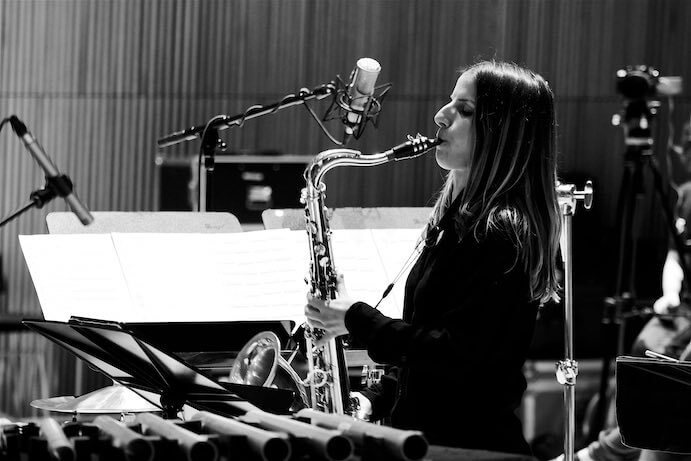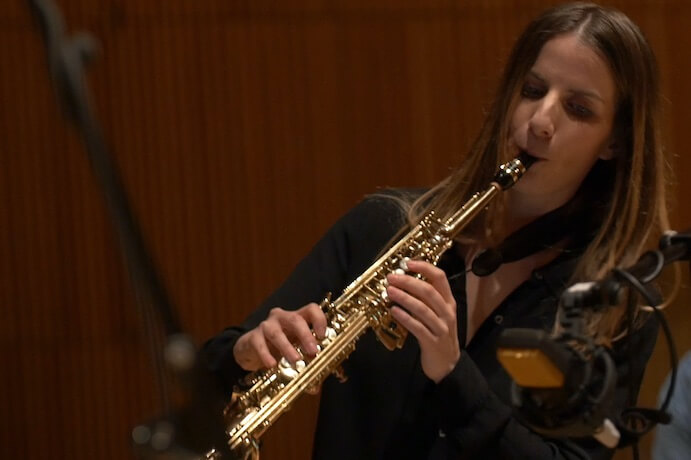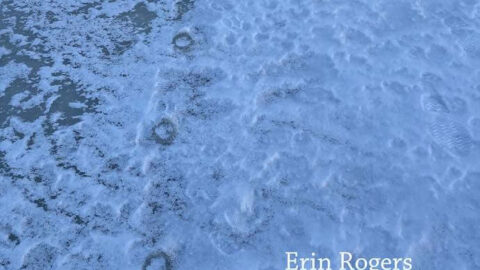“… a radiant world of imagination and curiosity, where beauty comes disguised.” This is how Erin Rogers describes 2000 Miles (Relative Pitch Records), her second album of music for solo saxophone. Recorded in a basement during a 14-day Covid quarantine, 2000 Miles emulates the visceral unease and desire for real humanistic connection that has defined the past year and a half. Rogers’ versatile approach to her instrument is marked by both a rawness of performance and unparalleled control, resulting in a gritty display of real-time composition and unusual colors.
Opening the album, Waxing (Home 1) muses around an individual note while never settling in to offer comfort. The stability of pitch wanes as the track progresses, incorporating increased percussive clanking of keys and broken multiphonics. Rogers’ ability to intertwine experimental techniques into a cohesive atmosphere is innovative beyond the sonic experience; her instinctive choices project an aura of complex emotive moods beautifully presented in each work on the album.

In a yearning to communicate, Rogers’ intimate relationship with the saxophone on North Star breaks traditional modes of listening and the concept of harmony. Voice and saxophone quickly dissipate into the subconscious, creating striving yet warm split tones that resonate in a remarkable counterpoint and beg the listener to wrap themselves in the communion. Rogers’ temporal acumen rips the other-worldly sonic experience back to a lonely reality in an outburst of pops and shrieking, and the sudden change opens space for the growth of a new sonic study.
Without the combination pitch between voice and saxophone, the emergence of a guttural muttering is amplified through the un-mouthpieced body of a tenor saxophone. Rogers’ authoritative performance on Angelface demands undivided attention to the intriguing, and at times deeply unsettling, ragged interactions with her senses. Even through the disturbing and pulsating textures, Rogers’ wandering consciousness traces a cohesive state of being deeply felt throughout the work.
Township Road 494 reveals more of the overarching essence of the album by extending to a resigned timbral nature. In the ethereal sounds of overtone partials gently swaying back-and-forth over subtle fundamentals, the inexpressible mastery required can easily go unappreciated. The profound fragility of the technique demands control over the smallest manipulations of air and embouchure; the slightest of misstep risks the total collapse of the sound world. The result is a hauntingly beautiful and mesmerizing soundscape most will be unable to replicate.

Home II and New Moon end the album, incorporating a greater focus on form and direction. Like the previous tracks, Home II focuses on one real-time composition technique to create the work, but here, the bisbigliando (tone trills) is done with more variance in range, speed, and time. Rogers adds to her unyielding energy by utilizing the diversity of options to reminisce on the mood of the previous tracks.
While the expansion of direction inside Home II offers more in the way of form, the final track dramatically expands the concept. New Moon ends the album and utilizes all techniques that each of the previous tracks singularly used while still focusing on one idea: expanding an individual multiphonic. Rogers showcases an incredible fluency and depth to weave together the previous complex series of colors and sounds to express a powerful and genuinely authentic conclusion.
It is hard to believe an hour’s worth of saxophone extended techniques and noises could remain engaging from beginning to end, but Erin Rogers does the improbable with 2000 Miles. What makes this album truly impressive is not just Rogers’ technical prowess, but the deep understanding of each techniques’ colors, power, and fragilities. The enormous undertaking to find fluency in such a unique soundworld is extraordinary, and Rogers’ dedication has produced album that can simultaneously captivate and challenge the listener.
I CARE IF YOU LISTEN is an editorially-independent program of the American Composers Forum, funded with generous donor and institutional support. Opinions expressed are solely those of the author and may not represent the views of ICIYL or ACF.
A gift to ACF helps support the work of ICIYL. For more on ACF, visit the “At ACF” section or composersforum.org.
























